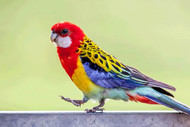Golden-Mantled Rosella Fact Sheet
Posted by Golden-Mantled Rosella Facts, what to feed a Golden-Mantled Rosella, caring for a Golden-Mantled Rosella, Rosellas on 9/1/2024
Scientific name:
Platycercus eximius
Common names:
Golden-mantled Rosella, Eastern Rosella, Red Rosella.
Note that the name Golden-mantled has passed into common use but correctly only refers to the sub-species cecilae, which is the most beautiful. Over the years, the sub-species in Europe have been crossed.
Adult length:
30cm (12in)
Adult weight:
90-115g
Potential lifespan:
20 plus years
Click here for goodies that are suitable for Rosellas.
Origin:
Australia, south, south-east, and Tasmania, as far north as south-eastern Queensland.
Status in wild:
Common, except in Tasmania.

Non-existent. In recent years some breeders have hand-reared these Rosellas to make them more saleable and to sell them to uninitiated people who think any colourful parrot will make a good pet.
This was due to the fact that along with many other inexpensive Australian Parakeets, over-breeding was occurring, making young birds difficult to sell. A sad fate awaits most hand-reared Rosellas.
When they mature, at just over one year old, they become very aggressive towards humans, bite hard and are no longer wanted in the home. (On rare occasions, females are more amenable.)
In the meantime, having been kept in a cage and perhaps even wing-clipped, they may develop psychological problems in frustration at lack of exercise.
These birds need to fly and even if let out daily for exercise, they are not happy, caged alone. As with other members of the genus, they do not have the temperament to become affectionate pets.
I recall the case of one Golden-mantled Rosella that became very aggressive towards its human companions. Because it had plucked itself very badly and had few body feathers, it could not be re-housed in an aviary. There was no future for this bird ? and all because it had been hand-reared.
Trying to make a breeding bird of a hand-reared female usually ends in disaster. Not having been socialised at an early age with birds of her own species, she does not understand the behaviour of the male who wants to breed, and is likely to be attacked and/or killed when she refuses to enter the nest-box.
If you see a female who has survived an attack, with part of the upper mandible missing, you can guess that she was hand-reared and useless for breeding.
Aviary Birds:
This has been a popular species due to its beautiful plumage and ease of breeding. In recent years the many available mutations have resulted in large numbers being reared.
It is interesting, however, to look at the numbers recorded in the Breeding Register of the Parrot Society, between the years 1975 and 2008. In 1975 members reported breeding 692.
This increased by about 200 per year until 1991 when the numbers peaked at 1,725. Since then there has been a marked decline to 313 in 2004, 140 in 2007 and only 97 in 2008.

While this partly reflects the reduced numbers of people breeding Parrots in the UK, it might also mean that breeders have reduced their stock due to difficulties of selling young.
It is worth noting that countless reports of brightly coloured parrots on the loose refer to this species. I suspect that some people are even releasing birds that they cannot sell.
Accommodation:
Pairs of Rosellas need an aviary at least 4.5m (15ft) long. They are often kept in smaller aviaries which is regrettable, as they are active birds that need an aviary of good length.
Males are very aggressive and should not be kept in an aviary next to another pair of Rosellas ? or the males will spend too much time bickering, possibly resulting in infertile eggs.
The floor of the aviary should be of concrete or a material that can be pressure-washed or well cleaned often. This is because Rosellas are susceptible to parasitic worms, the eggs of which might be ingested when they forage on the floor. They should be wormed twice yearly.
Click here for cages that may be suitable.
Diet:
They need a good quality Parakeet mixture containing a wide variety of seeds, such as canary, millet, hemp and buckwheat, and only a small quantity of sunflower seed (such as small striped).
Millet sprays are greatly enjoyed. Green food should be offered at least several times a week, such as seeding grasses, young leaves of dandelion and sow thistle, or spinach and Swiss chard.
When rearing young, egg food or moistened wholegrain bread (lightly sprinkled with a calcium additive), and extra green food are necessary.
For more food please click here.
Breeding:
This usually commences March or April. A suitable nest-box would measure approximately 30cm (12in) square and at least 60cm (2ft) deep.
They gnaw a lot so the box should be made of wood not less than 1.3cm (1/2in) thick. Five to seven eggs are laid and clutches as large as nine are known. The incubation period is 20 days and the young fledge after five weeks.
For everything else you need for Rosellas please click here.


